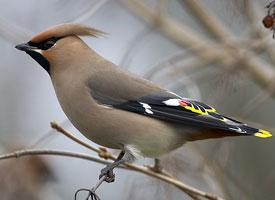
Popis zvířete
The Bohemian Waxwing (Bombycilla garrulus) is a captivating bird species known for its distinctive appearance and nomadic lifestyle. This medium-sized passerine, part of the waxwing family, exhibits a unique blend of soft, sleek plumage with striking color accents that make it a favorite among birdwatchers and nature enthusiasts.Adult Bohemian Waxwings are approximately 18 to 21 cm in length, with a robust, rounded body shape that exudes an air of elegance. Their wingspan can stretch from 32 to 35.5 cm, enabling them to glide gracefully through the air. One of the most remarkable features of this species is its rich, silky feathering, which primarily showcases a blend of gray, rose, and brown hues. The bird's head is adorned with a prominent crest that can be raised or lowered, depending on its mood or social interactions.
The face of the Bohemian Waxwing is characterized by a striking black mask that contrasts sharply with its pale brown head and gray body. This mask is edged with white, adding to the bird's distinguished appearance. Another distinctive feature is the small but conspicuous red tips on the secondary feathers of the wings, resembling sealing wax, which is how waxwings got their name. Additionally, the tail is tipped with a bright yellow band, and some individuals may have white or yellow markings on their wings, adding to their visual allure.
Bohemian Waxwings are highly social birds, often seen in large, noisy flocks, especially during the winter months when they roam in search of food. Their diet primarily consists of fruit and berries, but they can also consume insects during the breeding season. Their preference for berry-rich habitats often brings them into human-populated areas, where they are known to feast on ornamental berries.
Breeding mainly in the coniferous forests of the northern Palearctic, from Scandinavia across Russia to Alaska and northern Canada, the Bohemian Waxwing does not adhere to a fixed breeding territory as many other bird species do. Instead, their movements are unpredictable, driven by the availability of food sources, which can lead to irruptions into southern regions during the winter.
The call of the Bohemian Waxwing is a soft, pleasant trill, contributing to the bird's enigmatic presence. Unlike many other species, they are not known for their song, as their vocalizations are more subtle and less varied.
In terms of conservation status, the Bohemian Waxwing is currently classified as Least Concern by the International Union for Conservation of Nature (IUCN), indicating a stable global population. However, like all wildlife, they face threats from habitat loss and changes in their food supply due to human activities and climate change.
In conclusion, the Bohemian Waxwing is a mesmerizing bird species, revered for its striking appearance and nomadic lifestyle. Its ability to thrive in cold climates, combined with its sociable nature and distinctive plumage, makes it a fascinating subject of study and observation for bird enthusiasts and conservationists alike.
Nové fotografie zvířat
Top 10 zvířat
- Dolphin gull (Leucophaeus scoresbii)
- Diana monkey (Cercopithecus diana)
- Moustached guenon (Cercopithecus cephus)
- Galápagos tortoise (Geochelone nigra complex)
- Stone loach (Barbatula barbatula)
- Japanese macaque (Macaca fuscata)
- Russian tortoise (Testudo horsfieldii)
- Greek tortoise (Testudo graeca)
- Common flying dragon (Draco volans)
- Vendace (Coregonus albula)